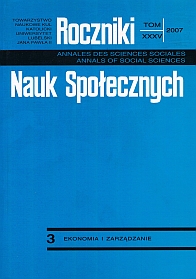Legal Factors to Standardise Products in the Markets of the European Union
Abstract
The paper depicts legal factors that determine the processes of standardising products and its elements of equipment (without a trademark) as instanced by the common market of the European Union. The author emphasises benefits for international enterprises from the creation of similar or identical products in many markets. One of the essential factors that favour standardisation of products is legal conditions. In the case of the European Union there are many common norms of a high degree of harmonisation. They have been implemented by member countries to their national legal orders. Enterprises working on the UE market can take advantage of the opportunities given by the unified legislation as regards products, and expand on the new markets with standardised products. The union law favours unification, especially with respect to the physical composition of products, and also to an extent with respect to the standardisation of packages and labels. The paper stresses also that the legal factors become a more and more important premise that encourage enterprises on the UE market to apply the standardised strategy of marketing-mix.
References
Biznes międzynarodowy – obszary decyzji strategicznych, red. M. K. Nowakowski, Warszawa: Wydawnictwo Key Text 2000.
Cateora P. R., Graham J. L.: International Marketing, New York: McGraw-Hill 2002.
Childs N. M., „Zielony” marketing, „Handel Wewnętrzny” 1995, nr 1.
Consumers in Europe. Facts and Figures. Data 1996-2000, Luxembourg: Eurostat 2001.
Domański T.: Globalization of brands – new challenges for marketing, w: Marketing and Globalization, Papers of the Third International Marketing Symposium, eds J. Dad'o, J. Wiktor, Cracow−Banska Bystrica 2000.
Dworzecki Z.: Opakowania w strategiach marketingowych producenta i dystrybutora, „Marketing i Rynek” 1994, nr 4.
Hales C. F.: Opakowanie jako instrument marketingu, Warszawa: PWE 1999.
Jahns H.: Wspólnotowa polityka harmonizacji technicznej – dyrektywy nowego podejścia, „Wspólnoty Europejskie” 1999, nr 12.
Janik - Wiszniowska M., Wiszniowski R.: Problematyka ochrony środowiska w reklamie wizualnej firm – tendencje i perspektywy, „Ochrona Środowiska. Prawo i Polityka” 1997, nr 3.
Kaczurba J.: Znak „CE” – zasady dopuszczania towarów do obrotu na Jednolity Rynek, w: Integracja z Unią Europejską. Poradnik dla przedsiębiorców, red. J. Kaczurba, Warszawa: Ministerstwo Gospodarki 2000.
Meffert H., Bolz J.: Standardization of Marketing in Europe, w: European Marketing. Readings and Cases, eds Ch. Halliburton, R. Hunerberg, Harlow: Addison Wesley 1996.
Mercado S., Welford R., Prescott K.: European Business, London: Prentice Hall 2001.
Prendergast G., Pitt L., Berthon P.: Packaging, the Environment, and European Legislation: Marketing's Response, „Journal of Euromarketing” 1997, vol. 6(2).
Wdrażanie dyrektyw opartych na koncepcji Nowego i Globalnego Podejścia. Przewodnik opracowany przez Komisję Europejską, Warszawa: Ministerstwo Gospodarki 2001.
Zou S., Cavusgil S. T.: The GMS: A Broad Conceptualization of Global Marketing Strategy and Its Effect on Firm Performance, „Journal of Marketing” 2002, vol. 66.
Copyright (c) 2007 Roczniki Nauk Społecznych

This work is licensed under a Creative Commons Attribution-NonCommercial-NoDerivatives 4.0 International License.


